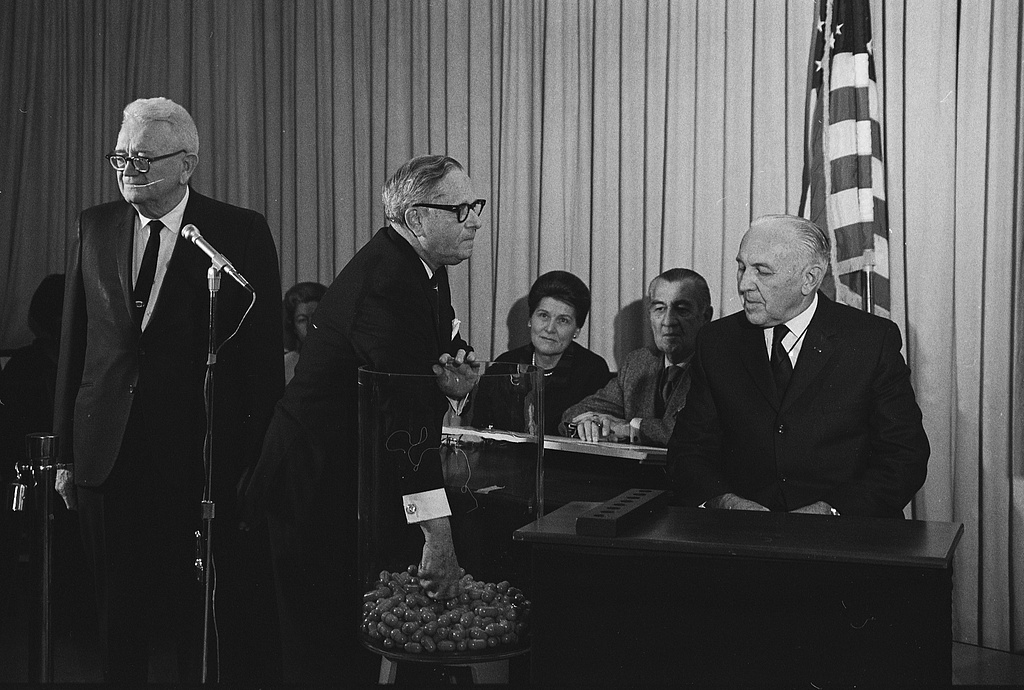Resistance on All Fronts: The Draft
At the time Bruce would have been drafted in 1969, the draft used to determine who would be sent to Vietnam underwent an overhaul. The new draft was based on a lottery system which assigned numbers 1-366 to the birthdate of eligible men. This attempted to create a randomized process to select military personnel for the Vietnam War and to maximize the number of young men, aged 19-26. In this system, the 366 days of the year were printed on slips, placed in capsules, and mixed. These capsules would then be drawn randomly as a spectacle on national television. Each date was numbered as it was drawn so that all participants with that birthday were assigned that number. Men would then be called to serve based on the number assigned to their birth date.
A study shows that the draft had massive social and economic consequences. Its compulsory nature increased resistance to military service.
Despite the apparent randomization, the draft system had a working-class bias. Initially, college and graduate school draft exemptions made it easy for those with the resources to enroll in higher education to avoid the draft. When the laws changed in 1969 and removed these exemptions, those with financial capability could access the legal or medical resources necessary to exempt or disqualify themselves from the draft. This often took the form of obtaining a psychiatric or medical disability or a conscientious objector status. Additionally, the opportunities for advancement and employment the armed services provided enticement for underprivileged groups.
Men with low lottery numbers who were facing the risk of being drafted could volunteer like Boedtker did, giving them the opportunity to choose which branch of the military they entered. He recalled his experience with the draft during the interview:
"I drew a very low number, so I knew that I was probably going to get drafted. And someone had told me, look, you're better off if you know you're gonna get drafted, you're better off going in and volunteering for the draft and then you can kind of pick and choose where you want to go. Not really, not so, but that's what I believed. So I didn't want to go to Vietnam and I was figuring that would be a good way for me to find a way not to go. I was going to get drafted anyway. My choices were to do that or take off to Canada. So I volunteered for the draft."
Others chose to evade the draft. In the last three years of the war, nearly 145,000 people obtained this conscientious objector status. Tens of thousands more simply refused induction. In Chance and Circumstance: The Draft, the War, and the Vietnam Generation, conscription scholars Lawrence Baskir and William Strauss cite that during the Vietnam era, 570,000 men classified as draft offenders. "Dodging" the draft could be punished by an upgrading of one's draft status, arrest, or imprisonment.
As Boedtker notes, some escaped the draft by emigrating to Canada. Tim O'Brien captures the emotional turmoil this may have elicited in The Things They Carried. He describes one draftee's decision to go to war, sitting in a boat only yards from the Canadian border:
"I did try.
It just wasn't possible.
All those eyes on me—the town, the whole universe—and I couldn't risk the embarrassment. It was as if there were an audience to my life, that swirl of faces along the river, and in my head I could hear people screaming at me. Traitor! they yelled. Turncoat! Pussy! I felt myself blush. I couldn't tolerate it. I couldn't endure the mockery, or the disgrace, or the patriotic ridicule. Even in my imagination, the shore just twenty yards away, I couldn't make myself be brave. It had nothing to do with morality. Embarrassment, that's all it was.
And right then I submitted.
I would go to the war—I would kill and maybe die— because I was embarrassed not to." (57)
Avoiding the draft became a form of protest. As shown by Penny Lewis in Hardhats, Hippies, and Hawks, during the course of the war, there were over a million and a half instances of absenteeism (being AWOL) recorded and half a million of these became deserters. The majority of these desertions occurred before soldiers even went overseas.
Publically, people would burn their draft cards to show their lack of support for the U.S.' military efforts. Formalized groups like the Boston Draft Resistance Group and the Wisconsin Draft Resistance Union even coached draftees in avoidance tactics.
This created an army of soldiers who largely did not want to be in combat. A survey showed that of the soldiers who served in Vietnam, one-third were true volunteers, one-third were draft-motivated volunteers (like Bruce), and one-third were drafted.
